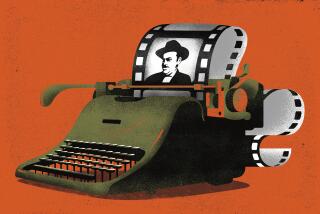On his birthday: Samuel Fuller, novelist?
When we think of Samuel Fuller — who was born 102 years ago today, in Worcester, Mass. — it’s as a filmmaker. “Pickup on South Street,” “Park Row,” “Shock Corridor,” “The Big Red One”: Fuller had a style all his own. Pulp-influenced, using melodrama as a device for social commentary, Fuller’s movies are gritty, naturalistic if not always realistic, relying on odd camera angles and cuts to reinforce the instability of the world.
The same intention (that of keeping us off-guard) also infused the way he did his work; he was, as Charles Ardai observes in the afterword to “Brainquake” (Hard Case Crime: 320 pp., $12.95 paper), “[a] gruff, snarling, cigar-chomping figure who used to fire a gun loaded with blanks to commence filming rather than calling Action!”
“Brainquake” reveals another side of Fuller, the filmmaker as novelist. Written in the 1990s while he was living in France (he died in 1997, at 85), it is being published on his birthday as something of a literary reclamation project, having never before been available in the United States.
The story of a New York City bagman named Paul Page who suffers from a debilitating brain ailment — the seizure-like condition of the title — it operates out of Fuller’s signature blend of noir and commitment, using its crime narrative to probe larger questions of loyalty.
“No one was paying him to rectify the situation,” he writes late in the novel. “True enough. But sometimes an extraordinary situation calls for unusual measures. And this was a matter of pride.”
Fuller, Ardai points out, began as a novelist in the 1930s and 1940s, with books such as “Burn, Baby, Burn!” and “The Dark Page.” Once he established himself in Hollywood, his fiction writing tailed off, but he never entirely stopped. “Brainquake,” then, is less an anomaly than representative of a kind of parallel career, lesser known but with a through line nonetheless.
The book begins, quite literally, with a bang: A baby, riding in a stroller that has been surreptitiously rigged by an assassin, kills his father by firing a gun wired to a pull string toy. The stroller is also loaded with explosives, leading to a standoff in Central Park. It’s a vivid, cinematic way to start a novel, and it allows Fuller to introduce Paul and a number of other principals, including the mother of the child.
As in his films, the focus is not on realism per se so much as on a heightened set of circumstances. Some situations are so over-the-top that they are not believable, but in the end, that matters less than the way they contribute to the overall dynamic, the tensions that define Paul’s world.
The territory of the novel, after all, is one in which nothing is as it appears, from the legitimate storage company that is a mob front to the hit man, known as Father Flanagan, who travels in the guise of a priest.
The implication, which also marks Fuller’s movies, is that there is no purity, that everything is corrupt or corruptible, a point-of-view reinforced by the novel’s denouement. Such a perspective, Ardai suggests, was hard-earned, arising out of Fuller’s experiences in World War II, many of which were dramatized in “The Big Red One.” Among his earliest film work were the images he shot as a soldier liberating Falkenau concentration camp.
That gives all of Fuller’s work a weight, a gravitas, that it might not otherwise possess. The same is true, as well, of “Brainquake,” which, while not a great novel is a fascinating one, pulp that aspires to tell us something about who we are.
Twitter: @davidulin
More to Read
Sign up for our Book Club newsletter
Get the latest news, events and more from the Los Angeles Times Book Club, and help us get L.A. reading and talking.
You may occasionally receive promotional content from the Los Angeles Times.







